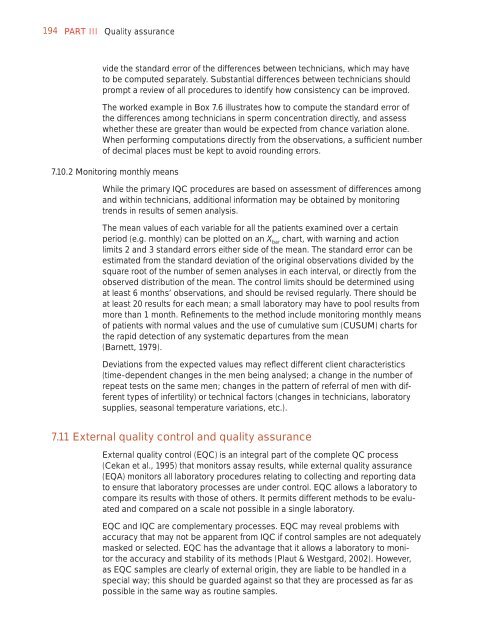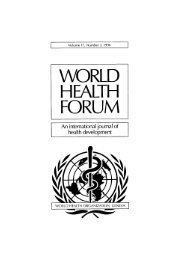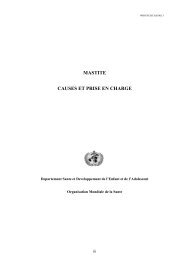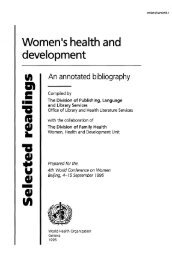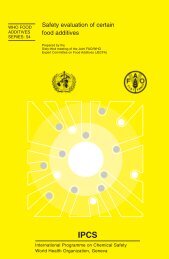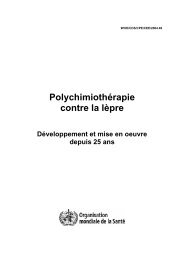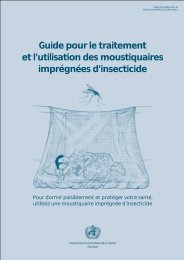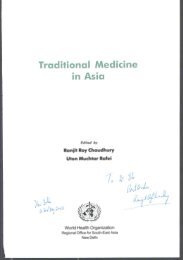Examination and processing of human semen - libdoc.who.int ...
Examination and processing of human semen - libdoc.who.int ...
Examination and processing of human semen - libdoc.who.int ...
You also want an ePaper? Increase the reach of your titles
YUMPU automatically turns print PDFs into web optimized ePapers that Google loves.
194 PART III Quality assurance<br />
vide the st<strong>and</strong>ard error <strong>of</strong> the differences between technicians, which may have<br />
to be computed separately. Substantial differences between technicians should<br />
prompt a review <strong>of</strong> all procedures to identify how consistency can be improved.<br />
The worked example in Box 7.6 illustrates how to compute the st<strong>and</strong>ard error <strong>of</strong><br />
the differences among technicians in sperm concentration directly, <strong>and</strong> assess<br />
whether these are greater than would be expected from chance variation alone.<br />
When performing computations directly from the observations, a suffi cient number<br />
<strong>of</strong> decimal places must be kept to avoid rounding errors.<br />
7.10.2 Monitoring monthly means<br />
While the primary IQC procedures are based on assessment <strong>of</strong> differences among<br />
<strong>and</strong> within technicians, additional information may be obtained by monitoring<br />
trends in results <strong>of</strong> <strong>semen</strong> analysis.<br />
The mean values <strong>of</strong> each variable for all the patients examined over a certain<br />
period (e.g. monthly) can be plotted on an X bar chart, with warning <strong>and</strong> action<br />
limits 2 <strong>and</strong> 3 st<strong>and</strong>ard errors either side <strong>of</strong> the mean. The st<strong>and</strong>ard error can be<br />
estimated from the st<strong>and</strong>ard deviation <strong>of</strong> the original observations divided by the<br />
square root <strong>of</strong> the number <strong>of</strong> <strong>semen</strong> analyses in each <strong>int</strong>erval, or directly from the<br />
observed distribution <strong>of</strong> the mean. The control limits should be determined using<br />
at least 6 months’ observations, <strong>and</strong> should be revised regularly. There should be<br />
at least 20 results for each mean; a small laboratory may have to pool results from<br />
more than 1 month. Refinements to the method include monitoring monthly means<br />
<strong>of</strong> patients with normal values <strong>and</strong> the use <strong>of</strong> cumulative sum (CUSUM) charts for<br />
the rapid detection <strong>of</strong> any systematic departures from the mean<br />
(Barnett, 1979).<br />
Deviations from the expected values may refl ect different client characteristics<br />
(time-dependent changes in the men being analysed; a change in the number <strong>of</strong><br />
repeat tests on the same men; changes in the pattern <strong>of</strong> referral <strong>of</strong> men with different<br />
types <strong>of</strong> infertility) or technical factors (changes in technicians, laboratory<br />
supplies, seasonal temperature variations, etc.).<br />
7.11 External quality control <strong>and</strong> quality assurance<br />
External quality control (EQC) is an <strong>int</strong>egral part <strong>of</strong> the complete QC process<br />
(Cekan et al., 1995) that monitors assay results, while external quality assurance<br />
(EQA) monitors all laboratory procedures relating to collecting <strong>and</strong> reporting data<br />
to ensure that laboratory processes are under control. EQC allows a laboratory to<br />
compare its results with those <strong>of</strong> others. It permits different methods to be evaluated<br />
<strong>and</strong> compared on a scale not possible in a single laboratory.<br />
EQC <strong>and</strong> IQC are complementary processes. EQC may reveal problems with<br />
accuracy that may not be apparent from IQC if control samples are not adequately<br />
masked or selected. EQC has the advantage that it allows a laboratory to monitor<br />
the accuracy <strong>and</strong> stability <strong>of</strong> its methods (Plaut & Westgard, 2002). However,<br />
as EQC samples are clearly <strong>of</strong> external origin, they are liable to be h<strong>and</strong>led in a<br />
special way; this should be guarded against so that they are processed as far as<br />
possible in the same way as routine samples.


